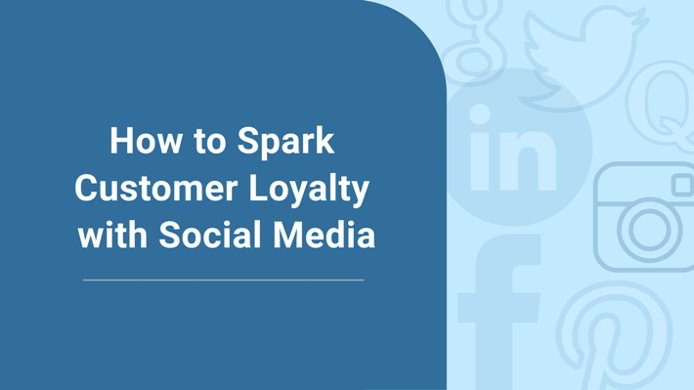There’s an old adage commonly said about customer retention: “It costs five times more to attract a new customer than to retain a current one.”
Customer acquisition costs have been growing for eCommerce businesses as competition multiplies and big brands get stronger. Relying purely on ads and PPC for customer acquisition is no longer sustainable; that’s why retaining customers becomes almost mandatory for brands that want to be successful.
So how do you retain customers? It starts with building relationships and interacting with your clients. And in today’s age, social media is one of the best tools to do that: it allows you to keep in touch with your audience and potential customers.
We’ve gathered eight tips on how to spark customer loyalty with social media.
#1 Engage with Customers
It’s up to you to put the “social” into “social media.” Don’t be afraid of a little human interaction. Take the time to respond to every comment or message you get on social media. If it’s a past customer that’s in love with what they’ve just bought, thank them for buying with you. It makes customers feel special and involved in your business. This type of interaction further encourages them to keep commenting and following your social media profile.
While engaging with your audience, you want to consider what your brand voice sounds like. How does your brand voice spark connections? Is it known for your smooth business style or easy-going posts and comments?
Take Wendy’s, for example. They have become notorious for their sassy comments online.

Not every brand can pull off roasting people on Twitter, but Wendy’s playful persona works for them because it creates an emotional connection with a younger audience.
#2 Share Your Brand Story & Values
64% of American consumers say their purchasing consideration is driven by a company’s ethical values and authenticity. More than ever consumers want to know that companies are doing the right thing. It’s no longer good enough to have your product work, but your business’s entire foundation needs to be ethical and transparent. So share your story and values with your audience. It humanizes your business and gives people a reason to believe in your brand outside of your product.
Take a look at Patagonia's Instagram page. Besides the photos of gorgeous landscapes, Patagonia also shares some brand values. One of their brand values includes ensuring employees don't have to choose between getting paid and getting to vote in elections.
Posting about Patagonia's values gives consumers an insight into what matters to them.

#3 Post what Your Audience Likes
We all know that posting high-quality content like infographics, videos, or beautiful imagery will inspire customer loyalty. But there’s more to it than just looking nice. What you share on social media usually meets at least one of two criteria:
- Encourages people to share, like, or comment
- Shares valuable or useful content with your followers
The goal is to connect with your audience personally and inspire them to further interact with your brand. People like to see a personal side of a business, and one way to show this side is to take your audience “behind the scenes”. Show them what’s going on with your business by sharing company events or posting pictures of your employees’ pets.
Christy Dawn is a sustainable clothing line for women. One way they give a glimpse behind the scenes is by creating content on how they pick out fabric for their clothes. This is important to their audience because they care deeply about sustainability.

#4 Create Interactive Content
Want to take your social media content further? Make it interactive. Get your followers to participate and engage with your content. Here are three ideas to get you started:
1. Quizzes and polls
Twitter, Facebook, and Instagram Stories all have options to create and share built-in polls. You can ask your audience to name a new product, determine “this or that” scenarios, or select what they want to see from your brand.
You can do even more with Instagram Stories’ built-in question feature. You ask the audience a question, and they respond, which can be great for “caption this picture” content.
2. User-generated content
User-generated content (UGC) is content that your users create about your brand or product. Nearly two-thirds (61%) of consumers say that UGC encourages them to engage with brands.
Examples of UGC include videos, social media posts, pictures, testimonials, and blog posts.
You can encourage your audience to post about you and tag your profile. And then, you can reshare your audience’s content on your social media profiles.
Even Target is doing it!

Everyone loves a shout-out from their favorite brand—this fosters customer loyalty with your fan base.
3. Ebooks
Your brand attracts people who have interests in common, beyond the product you’re selling. For example, if you’re an eCommerce store selling basketball shoes, it’s extremely likely that all of your customers are also basketball lovers.
Why not generate content that would pick their curiosity? Write a short ebook that customers can read with useful and engaging content about the topic they love. You can use FlippingBook to create awesome online ebooks with custom branding and videos.
#5 Start a Rewards Program
Creating a customer loyalty program is key to getting returning shoppers. A solid rewards program will encourage certain spending behaviors from customers by giving them special benefits.
For example, you can reward customers for engaging with you on social media. They can earn points for future discounts, and you get a chance to build relationships with your loyal customers on social media.
WelleCo did an excellent job getting customers to earn points through its holiday social media strategy. As part of their 12 days of giveaways, customers had the opportunity to earn three times the points if they shopped that weekend. The Instagram post also invites customers to join their loyalty program to reap the rewards.

WelleCo was able to promote their loyalty program seamlessly with other giveaways as part of their holiday campaign.
Keep in mind that you can take a rewards program a step further by rewarding customers with referrals incentives as well. For example, if you build and sell online courses, you can give your current students a percentage of the sale every time they refer a new student to you. This can be especially powerful with social media because that social proof of others joining the course leads to FOMO (fear of missing out), which may create even more demand. Rewarding your most active social media followers will promote positive feelings that could boost brand loyalty.
#6 Provide Top-Notch Customer Service
Nowadays people spend a considerable amount of time on social media. As a result, it's no wonder that customers demand social media customer care and 56% of customers stay loyal to brands that understand their needs.
Technology has allowed companies to respond to customers in record time. And that’s exactly what customers expect. Research shows that 90% of consumers consider an immediate response to a customer service inquiry important. And how fast is an immediate response? 60% say it’s 10 minutes or less.
So how can you meet this demand? Add chatbots. Chatbots use machine learning to answer questions from a customer. They can be used to help companies book appointments, provide customer service, or answer frequent questions. Chatbots are supplementary to live chat on social media. It’s an incredibly useful tool that could increase customer satisfaction and decrease call volume. For businesses focusing on outsourcing customer service, integrating chatbots can streamline operations and enhance customer experience.
Providing a better experience with instant customer service can only increase loyalty.
#7 Respond to Reviews
Reviews can exist on Facebook, Yelp, Google, and other social media platforms. Take the time to thank the person that wrote positive comments, and resolve any negative reviews.
Don’t make the mistake of ignoring negative reviews. 82% of shoppers seek out negative reviews because they are deemed more authentic than overly positive reviews. Of course, positive reviews are still necessary since 72% of consumers will read reviews before making any purchasing decisions. But responding to negative reviews can show a potential customer that you genuinely care about their experience, and that you go above and beyond to take care of an unhappy customer.
There are many ways to encourage customers to write reviews. You can send product review emails to customers and incentivize them to leave reviews on social media. You can share positive feedback on your social media profile and thank the customer for purchasing. It also doubles as social proof, which provides evidence to customers that your brand is trustworthy.
Take a look at this email example sent from DiveThru, a guided journaling app. They celebrated the launch of their podcast with a giveaway, and one of the tasks to enter was to write a review on Apple Podcasts.

Source: DiveThru Email Newsletter
#8 Use Influencers
Love 'em or hate 'em, social media influencers can spark customer loyalty. 8 out of 10 people have purchased something after seeing it recommended by an influencer.
Why do customers trust influencers? It all goes back to the idea that customers view real-life people as more honest than any advertising from a brand. So when someone says this is a good product, people believe it.
How can you incorporate influencer marketing into your overall strategy? You can ask influencers to write a review about your product and give them a personalized referral code to share with their followers. You can earn new customers, and those customers will get a discount to foster loyalty.
Let's take a look at an eyewear company, Hawkers. It recently launched a campaign filled with online influencers like Marià Casals. Seeing a favorite influencer in a marketing campaign can make someone feel excited about the product the influencer is endorsing. So you might earn some new customers by incorporating influencers into your campaign.

Building Customer Loyalty Takes Time
Earning a customer’s trust doesn’t happen overnight. You have to foster loyalty by building a relationship. And there are no shortcuts to great relationships. Try different combinations of these loyalty-building strategies and see how your audience responds. Your data metrics will tell you what is worth keeping and what needs refining.
Just remember that building customer loyalty is a continuous process, but you’ll reap the rewards of returning customers when you keep going.
Author's bio:
Raul Galera is the Partner Manager at ReferralCandy and CandyBar, two tools helping small and medium businesses run customer referral and loyalty programs. He’s been working in the tech sector for the past seven years and regularly writes about marketing, eCommerce, and tech.





